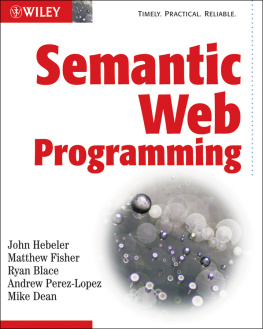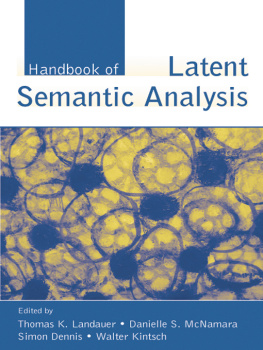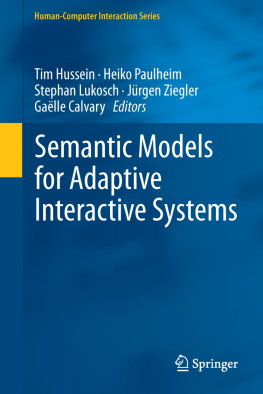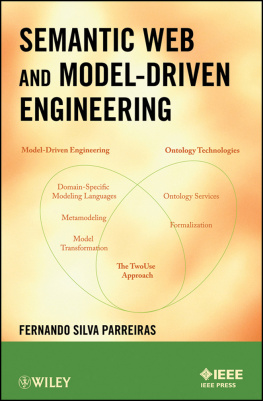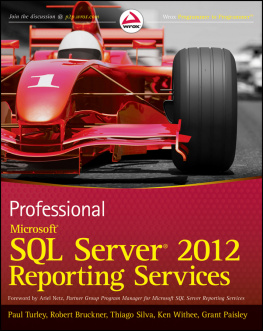Semantic Web Programming
Published by
Wiley Publishing, Inc .
10475 Crosspoint Boulevard
Indianapolis, IN 46256
www.wiley.com
Copyright 2009 by Wiley Publishing, Inc., Indianapolis, Indiana
Published simultaneously in Canada
ISBN: 978-0-470-41801-7
Library of Congress Cataloging-in-Publication Data is available from the publisher.
No part of this publication may be reproduced, stored in a retrieval system or transmitted in any form or by any means, electronic, mechanical, photocopying, recording, scanning or otherwise, except as permitted under Sections 107 or 108 of the 1976 United States Copyright Act, without either the prior written permission of the Publisher, or authorization through payment of the appropriate per-copy fee to the Copyright Clearance Center, 222 Rosewood Drive, Danvers, MA 01923, (978) 750-8400, fax (978) 646-8600. Requests to the Publisher for permission should be addressed to the Permissions Department, John Wiley & Sons, Inc., 111 River Street, Hoboken, NJ 07030, (201) 748-6011, fax (201) 748-6008, or online at http://www.wiley.com/go/permissions.
Limit of Liability/Disclaimer of Warranty: The publisher and the author make no representations or warranties with respect to the accuracy or completeness of the contents of this work and specifically disclaim all warranties, including without limitation warranties of fitness for a particular purpose. No warranty may be created or extended by sales or promotional materials. The advice and strategies contained herein may not be suitable for every situation. This work is sold with the understanding that the publisher is not engaged in rendering legal, accounting, or other professional services. If professional assistance is required, the services of a competent professional person should be sought. Neither the publisher nor the author shall be liable for damages arising herefrom. The fact that an organization or Web site is referred to in this work as a citation and/or a potential source of further information does not mean that the author or the publisher endorses the information the organization or Web site may provide or recommendations it may make. Further, readers should be aware that Internet Web sites listed in this work may have changed or disappeared between when this work was written and when it is read.
For general information on our other products and services please contact our Customer Care Department within the United States at (877) 762-2974, outside the United States at (317) 572-3993 or fax (317) 572-4002.
Trademarks: Wiley and the Wiley logo are trademarks or registered trademarks of John Wiley & Sons, Inc. and/or its affiliates, in the United States and other countries, and may not be used without written permission. All other trademarks are the property of their respective owners. Wiley Publishing, Inc. is not associated with any product or vendor mentioned in this book.
Wiley also publishes its books in a variety of electronic formats. Some content that appears in print may not be available in electronic books.
To my wife, Christi, who for twenty-five years continues to offer support, wisdom, and love while putting up with my innate geekiness.
And to my dad, John, who gave me the gift of curiosity. Thank you!
John Hebeler
To Brenna, Denny, Brody, Mallory, Grace, and Olivia: You had patience in a father whose playtime and energy slipped while I wrote this book, but your love never falteredyou are each a blessing. To Erin, my wife, who had the world at her feet and still chose to be with me. You make this world a better place to be. I am the luckiest.
Matthew Fisher
To my parents, Jorge and Kathleen; to my siblings, Dan, Tom, Anya, and Tonya; and to Erika. Without your love, patience, and support I could never have written this book. Thank you!
Andrew Perez-Lopez
To my beautiful and infinitely patient wife Luci, for allowing me to spend nights and weekends writing this book. And to my kids, Daisy, Mini, Midas, India, and Lily, for providing plenty of mental health breaks.
Ryan Blace
To my wife, Nancy, and my sons, Jason and Noah, for allowing me the time to review chapters.
Mike Dean
About the Authors
John Hebeler is an avid, aging, yet still excited explorer of new technologies for the development of large-scale, distributed systems. In the last five years, he has focused on the Semantic Web and emergent, distributed systems. He has published several papers, has co-written a P2P networking book, and presents at major technical conferences around the world. He is currently pursing his PhD in Information Systems at the University of Maryland. He is a division scientist for BBN technologies.
Matthew Fisher has over fifteen years experience in the fields of software and systems development. He has worked in a wide range of engineering environments, ranging from small technology startups and research and development companies to large Fortune 50 firms. He regularly contributes to the Semantic Report and has been involved with conferences such as OWLED, ISWC, and the Semantic Technology Conference. Matthew is a principal systems engineer at Progeny Systems and holds a BS in Computer Science from Penn State University and a MS in Computer Science from George Mason University.
Andrew Perez-Lopez is a software developer who has worked at BBN Technologies since 2005 on large-scale information integration systems using the Semantic Web technologies discussed in this book. He holds an MS in Computer Science from Virginia Tech and an BA in Cognitive Science from the University of Virginia.
Ryan Blace has been a Semantic Web developer and BBN Technologies employee for five years. He works on multiple large-scale Semantic Webbased knowledge management systems for the government and commercial sectors. Ryan holds a BS in Computer Engineering from the University of Maryland and is pursuing his master's in Computer Science at Virginia Tech. When not spending late nights on his computer hacking away, Ryan spends his time cycling, mountain biking, and instructing at car club track days.
About The Technical Editors
Mike Dean (reviewer/editor) is principal engineer at BBN Technologies, where he has worked since 1984. He started working with Semantic Web in 2000, as a principal investigator in the DARPA Agent Markup Language (DAML) program. He was co-editor of the W3C OWL Reference, a co-author of SWRL, and has developed various Semantic Web tools, data sets, and applications. He currently provides technical direction for a number of Semantic Web projects at BBN. He holds a BS in Computer Engineering from Stanford University.
Mike Smith (technical editor) is a senior engineer at Clark & Parsia LLC, a software development and consulting firm specializing in the development and application of artificial intelligence technologies. Mike is a member of the W3 OWL WG, participates actively in the OWL community, and publishes content at http://clarkparsia.com/weblog/. He is one of the primary developers of Pellet, the open-source OWL reasoner, and frequently contributes to the Protg and OWL API projects. He holds BS and MS degrees in Systems and Information Engineering from the University of Virginia.
Credits
Executive Editor
Robert Elliott
Development Editor
Christopher J. Rivera
Technical Editor
Michael Smith
Production Editor
Melissa Lopez
Copy Editor
Linda Recktenwald
Editorial Manager
Mary Beth Wakefield
Production Manager
Tim Tate
Vice President and Executive Group Publisher
Richard Swadley
Vice President and Executive Publisher

